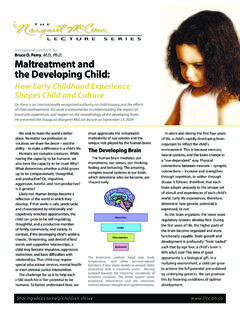Transcription of What Works in Prisoner AOD Treatment 360Edge 2018
1 What Works . Alcohol and other drug Treatment in prisons. 360 Edge 2018. Linda Jenner, Jarryd Bartle & Nicole Lee 1300 988 184. 3. In brief. People with alcohol and other drug Evidence of effectiveness is strong for: problems are over-represented in the Prison needle and syringe programs criminal justice system and prisons Tailored cognitive behavioural provide a unique opportunity to address therapy programs (both short- and these problems. long-term). The dynamics of the relationship Individual counselling between alcohol and other drug use and Opioid substitution therapy crime is complex and Treatment in justice Therapeutic communities settings should reflect evidence-based Exit preparation programs (including practice, and target factors that are pre-release centres).
2 Associated with criminal behaviour. Evidence of effectiveness is moderate It is important to address the needs of for: subpopulations of prisoners, including Motivational interviewing women, Aboriginal and Torres Strait Therapeutic groups Islanders, young adults, individuals with low literacy, those from diverse cultural Evidence of effectiveness is insufficient and language backgrounds, and for: prisoners with comorbid mental health Peer educator programs issues or an acquired brain injury. Contingency management Twelve-step peer support groups, except as an adjunct to therapeutic interventions Mindfulness based relapse prevention over traditional' CBT. 4. Contents. Substance use and the justice system.
3 5. Drugs other than People who use drugs by Alcohol use ..6. Relationship between substance use and offending ..6. Context of AOD Treatment in prisons ..7. Effective AOD interventions for prisoners.. 8. Screening and assessment ..8. Harm reduction Intensive interventions .. 13. Service types .. 19. Prisoners with specific needs.. 24. 24. Aboriginal and Torres Strait Islander 25. People with comorbid mental health problems .. 27. Young 29. People from culturally and linguistically diverse backgrounds .. 31. People with acquired brain injury .. 31. People with low literacy .. 33. References.. 34. 5. Substance use and the 01 justice system. The prevalence of alcohol and other (37%), followed by heroin (15%), ecstasy drug (AOD) use among people involved (9%) and cocaine (8%).
4 A further 17 per in the criminal justice system is cent had used analgesics/pain killers, 16. significantly higher than the general per cent reported tranquilliser or population. sleeping pill use, and 13 per cent had Data from the 2015 National Prisoner used other' analgesics (Australian Health Data Collection showed that 67 Institute of Health and Welfare 2013). per cent of prisoners reported use of an People who use drugs by injection illicit drug in the previous 12 months A 2013 survey found that 45 per cent of (Australian Institute of Health and Australian prison entrants had injected Welfare 2015), compared to about drugs at some time in their lives, while 67. sixteen per cent of the general per cent of that group had used a drug population aged 14 years and over in by injection in the month prior to the 2016 (Australian Institute of Health and survey (Butler, Callander et al.))
5 2015). Welfare 2017). According to the 2015 Health of Drugs other than alcohol Australian Prisoners Report, 10 per cent National data from the Drug Use of a sample discharged from prison Monitoring in Australia program (DUMA) reported using illicit drugs whilst in showed that in 2014 nearly 73 per cent prison, and six per cent reported using of police detainees tested positive to at drugs by injection while in prison least one drug that was not alcohol (Australian Institute of Health and (Coghlan, Criminology et al. 2015). That Welfare 2015). finding was consistent with an earlier One study found that among a group of study which found one third reported people who injected drugs and had a using two or more drugs in the 30 days history of imprisonment, almost one-half prior to being detained (Sweeney and had injected while in prison (Fetherston, Payne 2011).
6 Carruthers et al. 2013). In 2012, 70 per cent of Australian prison entrants had used any illicit drug in the past 12 months, most commonly cannabis (50%) or methamphetamine 6. Alcohol use and involvement in criminal activity (Payne and Gaffney 2012). Risky alcohol use is also highly prevalent among prison populations. In 2015, 39 Data from the DUMA program indicated per cent of Australian prison entrants that nearly half of all detainees surveyed reported consuming alcohol during the in 2013 reported that use of alcohol and previous 12 months at levels that placed or drugs was a contributing factor to them at risk of alcohol-related harm their most recent offending (Coghlan, (Australian Institute of Health and Criminology et al.)
7 2015), which is Welfare 2015). consistent with international findings (Bahr, Masters et al. 2012). Furthermore, Certain groups of prison entrants were continued AOD use, concurrent alcohol more likely to drink at risky levels such as and drug use in particular, has been offenders who were Aboriginal (54% vs. shown to be predictive of re-offending 33% of non-Aboriginal prisoners) and (Dowden and Brown 2002). male offenders (40% vs. 28% for females). Evidence also shows that different patterns of use have varying Relationship between substance relationships with offending. For use and offending example, a 2008 meta-analysis of thirty The dynamics of the relationship predominantly US-based studies found between drug use and crime is complex, that the likelihood of offending was and the topic has generated a about three to four times greater for considerable body of literature over people who used drugs when compared many decades.
8 To those who did not, and that the odds of offending varied across different Substance use has been associated with substances used: six times higher for a range of offences including those people who used crack' cocaine, three related directly to drug possession or times higher for people who used heroin, sale; offences related to drug acquisition and one and a half times higher for such as stealing; and offences related to people who used cannabis (Bennett, lifestyle factors that predispose people Holloway et al. 2008). who use drugs to engage in criminal activity (National Institute on Drug Abuse Implications for AOD Treatment (NIDA) 2012). Around half of all Australian prisoners While debates continue over whether are likely to meet criteria for substance AOD use is a causal factor in criminal dependence (Casey and Day 2014).
9 Activity, evidence does show a Given the high prevalence of AOD. relationship between levels of drug use problems among people in Australian 7. prisons and the relationship between Criminogenic factors that are amenable AOD use and its potential influence on to change - so called dynamic risk re-offending, the period of imprisonment factors' - are targeted by a matched type represents an excellent opportunity to and dose of intervention (Wooditch, Tang deliver evidence-based Treatment , which et al. 2014). People with a higher risk of is described in Section 2. re-offending generally receive higher intensity interventions. Context of AOD Treatment in prisons AOD interventions AOD use is one of a range of dynamic AOD Treatment within criminal justice settings should not only be delivered in risk factors open to change through accordance with the evidence base for evidence based Treatment .
10 Other effectiveness among the general dynamic risk factors include offending- population, but should also target factors related attitudes, beliefs and values;. that are associated with criminal impulsive behaviour; and poor problem- behaviour, particularly the attitudes and solving, self-regulation and coping skills. beliefs that contribute to offending The following section on what Works (National Institute on Drug Abuse (NIDA) examines AOD use outcomes ( 2012). reduced AOD use, reduction of AOD- related harms, improved quality of life) as The risk-need-responsivity model well as impact on re-offending which is In the criminal justice system, the main relevant to the criminal justice setting.




